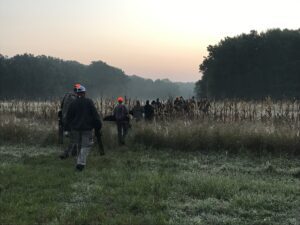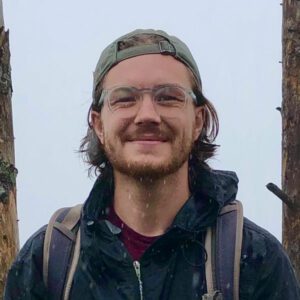Academics Afield: Outdoor Access, Hunter Education, and the Future of Conservation

Bluestem grass and wild blackberry bushes glow in the new sun of a September morning in North Carolina. Chickadees and finches chase one another from stem to stem – but remain still as a single word is called out in the distance.
“Pull!”
The call is followed by the loud, singular crack of a shotgun blast… and then a chorus of congratulatory cheers and laughter. Any unknowing observers might assume something unusual is happening here. In the best way possible – they might be correct.
–
“Raise your hand if you’ve ever done any target practice with a gun. Actually, on second thought… raise your hand if you’ve never even touched a gun in your life.”
Of the nine students gathered in the room, five of them tentatively raised their hands.
“That’s okay, no need to be bashful,” Academics Afield Program Lead Rick Echols says with a smile, gesturing towards an unloaded shotgun on the table in front of him, “Guns are dangerous, and can be overwhelming at first. But we’ll take it slow and walk through all you need to know about the mechanics, and how to safely use them.”

Academics Afield students determining their dominant eye during lecture prior to clay shooting.
The students and six program mentors are gathered in the main room of Wake County Wildlife Club in Durham, North Carolina. Despite the taxidermy arranged on the fireplace, and the firearms lecture taking place, the plaques on the wall (including several NCWF Governor’s Conservation Achievement awards) communicate a clear message: this is not a hunting club, nor is it a shooting club. This place is built around wildlife conservation and education.
The fifteen participants gathered today are taking part in an Academics Afield clay shooting event, one of many skill-building activities planned for this semester’s group of college students. All these activities through Academics Afield work towards one common goal: access, education, and ethics.
The Academics Afield program offers an R3 (Recruitment, Retention, and Reactivation) wildlife- related curriculum and quality mentored hunting and shooting sports opportunities to participants of non-hunting backgrounds – all free of charge. The program’s aim is to remove barriers and bridge divides for college students across all backgrounds. At the moment, the majority of these college students are recruited from NC State University, where Richard von Furstenberg coordinates and advertises the program through newsletters and word of mouth.
“Unless you’re born into hunting, there are not many avenues into it. And given hunting’s unique relationship with conservation, that can sometimes mean that you have no avenue into conservation, either.” says Rich, “Academics Afield is an interesting avenue in, or at least a
chance to talk to some hunters and conservationists. That’s hard to do if you don’t have that network.”
While most are from NC State University, the nine college students gathered in this room represent a broad range of backgrounds and
experiences. One is an undergraduate senior, majoring in civil engineering. Another is from New Jersey and has never touched a gun. And yet another was recruited by Rich after bumping

Academics Afield students gathered for firearms safety training prior to group dove hunt.
into each other while fishing at a neighborhood pond. Despite their differences, they all have
one thing in common: prior to participating in Academics Afield, none of them had any experience with hunting or understood how it relates to state conservation efforts.
The educational activities and skill-building that takes place throughout the program lead up to a hunting excursion for the students, accompanied by mentors. The hunting trips vary and may include dove, deer, or other species. However, The Academics Afield mentors acknowledge that merely handing someone a firearm and sending them out into the woods is a recipe for disaster. A fully rounded curriculum, including a Hunter Education course, is necessary to ensure that students are prepared for their journey.
Prior to hunting, the Academics Afield students participate in webinars on the biology of the game species they will be hunting, and the role that hunting plays in wildlife and habitat conservation. Many of the students enroll in the program to learn how to harvest their own food, deepen their relationship with nature, or to learn how to manage wildlife to achieve conservation and management goals, including curbing  disease transmission in wildlife. The message is that – while it can certainly be fun and engaging – hunting, at its roots, is about maintaining a
disease transmission in wildlife. The message is that – while it can certainly be fun and engaging – hunting, at its roots, is about maintaining a
connection and relationship with the natural world. It is a call to ethical stewardship. Many hunters understand and acknowledge the ecological benefits of wildlife and habitat to the larger ecosystem and work to protect and improve land to maintain healthy wildlife populations for future generations.
This emphasis on proper education is why much of the morning before the clay shoot is taken up by a lecture on shotgun mechanics and firearm safety, a discussion that nonetheless keeps the students enraptured.
“I learned some gun safety at Boy Scout camp,” says one of the students, “but nothing like this. I didn’t know how shotguns really worked or what shells to get for hunting… and I had no idea how much all of that played into conservation.”
In 1937, the Pittman-Robertson Act was passed to address the decline of wildlife species across the country. The act established an excise tax on the sale of firearms and ammunition, including those used for hunting. The funds collected from the excise tax are funneled directly into outdoor education programs and provide the majority of state wildlife agency funding, fueling conservation efforts.
“A lot of people don’t understand that the hunting and shooting sports community is a primary supporter of much of the state’s conservation and land management,” says NCWF Director of Wildlife Resources Dr. Liz Rutledge, “Academics Afield works to connect those dots for people, particularly these students.”

On the hike in to an Academics Afield dove hunt.
The Academics Afield program was originally started with funding from the U.S. Fish and Wildlife Services’ Wildlife and Sport Fish Restoration program, with North Carolina being one of numerous states participating in the southeast. When this initial funding expires, the funds needed to continue the program in North Carolina will come primarily from the Wake County Wildlife Club, which raises money for wildlife and conservation and education programming through the Dixie Deer Classic. The Classic is an annual exhibitor-based show that celebrates hunting in the south and is held at the North Carolina State Fairgrounds in Raleigh in early spring of each year, attracting thousands of people from far and wide.
The funds generated from the Dixie Deer Classic, to be allocated towards Academics Afield, will allow students to continue to participate in the program free of charge–except each student is asked to purchase a North Carolina hunting license to participate in the full array of program opportunities. Funds from the purchase of hunting licenses provide support for wildlife conservation and habitat management through the state wildlife agency, the North Carolina Wildlife Resources Commission.
Through grant funding supplied by the Wildlife and Sport Fish Restoration Fund, NCWF has been able to support the Academics Afield program partners by purchasing firearms and archery equipment to continue hosting these educational opportunities for students in the future. Pending further funding and volunteer support, the program has its sights set on expanding to more universities and colleges across the state, engaging more students in outdoor activities that may have previously been inaccessible to them.
“These college students naturally make great participants for this because they’re in this mode of engaged learning, so they’re very quick to pick up on the material. They don’t come in with any preconceived notions, and that’s really gratifying from an instructor’s point of view.” says Rick. “It creates a very welcoming environment. They put this modern face on conservation, which is crucial, especially as hunters are getting older and aging out.”
–

Academics Afield student and instructor during clay shoot.
“Don’t say ‘pull’…” Rick says to the group of students, now wearing protective ear and eye-wear, “Say ‘PULL!’”
The students laugh, shaking off the nerves of this new and exciting experience. They are now out at the firing range, preparing for their first experience in taking aim at sporting clays. The aim of shooting sporting clays is to hone your aim and make an accurate shot at a four-inch-wide neon orange clay disk that’s hurled through the air like a frisbee.
“So… who’s up first?”
Caroline – brave, but clearly nervous – is the first to step up to the plate. On the elevated platform overlooking the field, a mentor instructs her to pull the butt of the shotgun close to her

Academics Afield students and instructors following a successful clay shoot.
shoulder, keep the barrel pointed downrange, keep the safety on until she’s ready to shoot… and then give the ‘ready’ call.
“PULL!’” She calls loud and clear.
At the push of a button, a spot of orange hurtles through the sky. After a moment of surprise – Caroline refocuses herself and tracks the clay through the sky, moving the barrel of her shotgun just ahead of the clay… and she pulls the trigger. A cloud of clay dust rains down onto the field, and the rest of the participants break into cheers and applause.
“If you can’t say this is exciting, I don’t know what to tell you!” Rick laughs and prepares the next student to take the stand.
Written by:

– Written by Bates Whitaker, NCWF Communications & Marketing Manager


